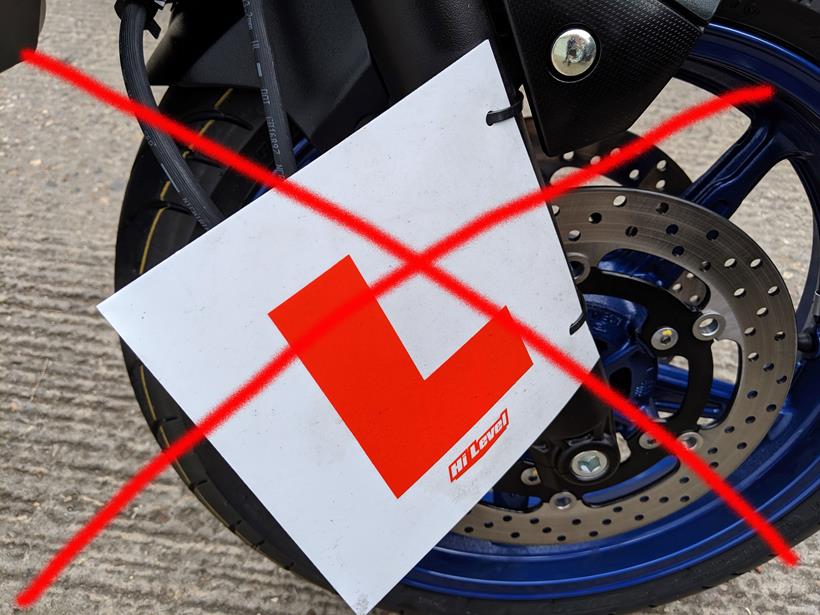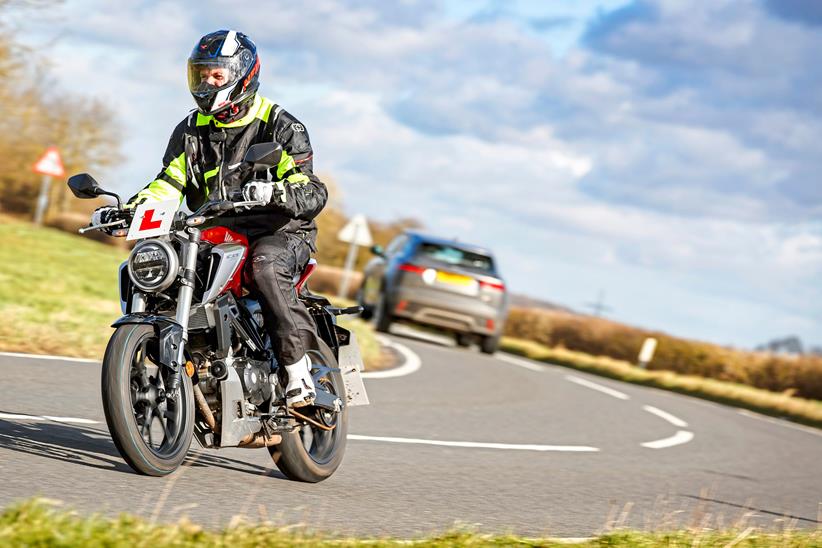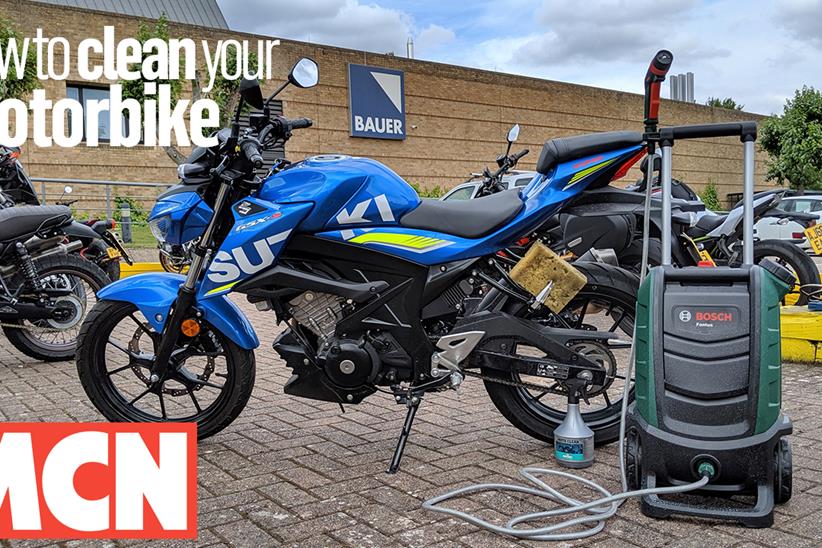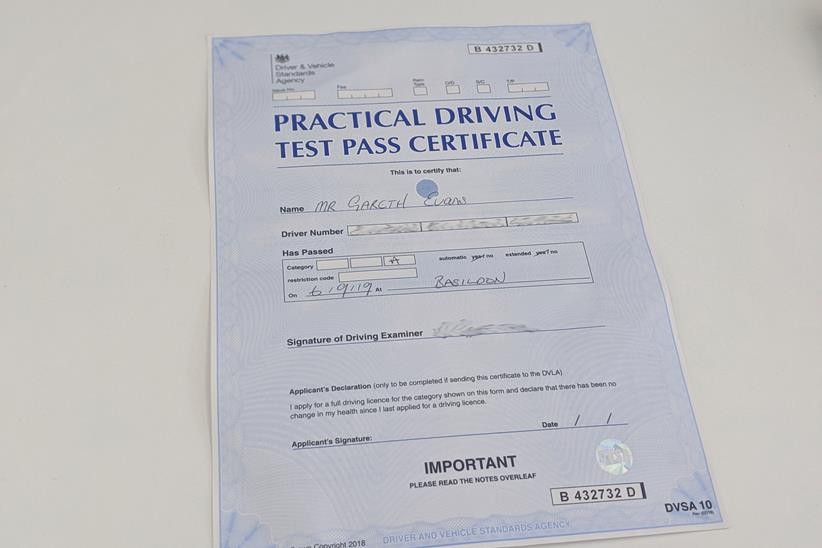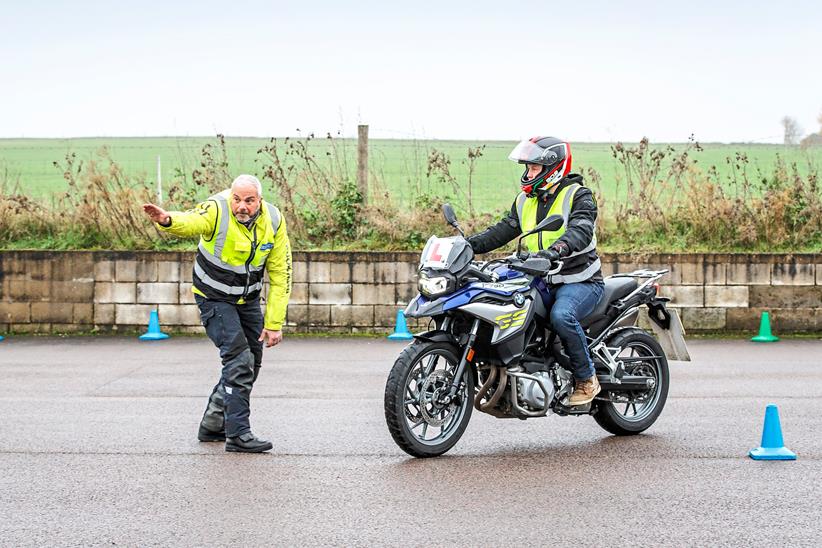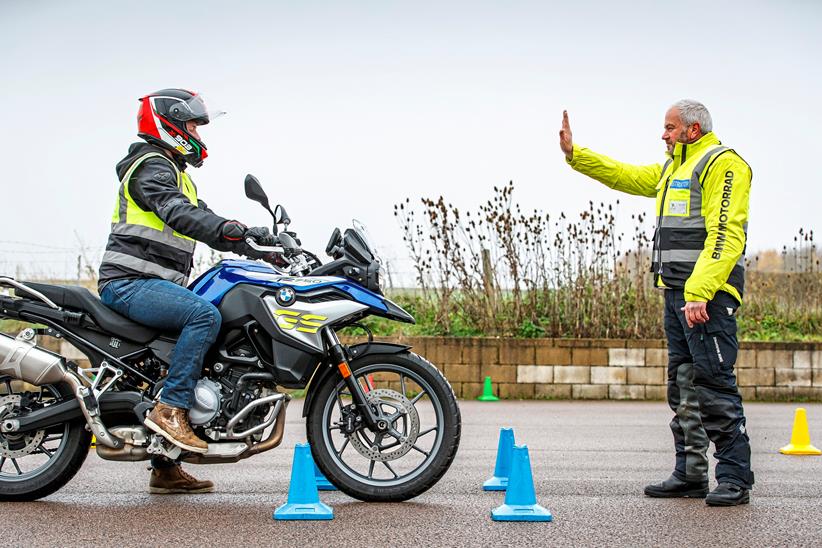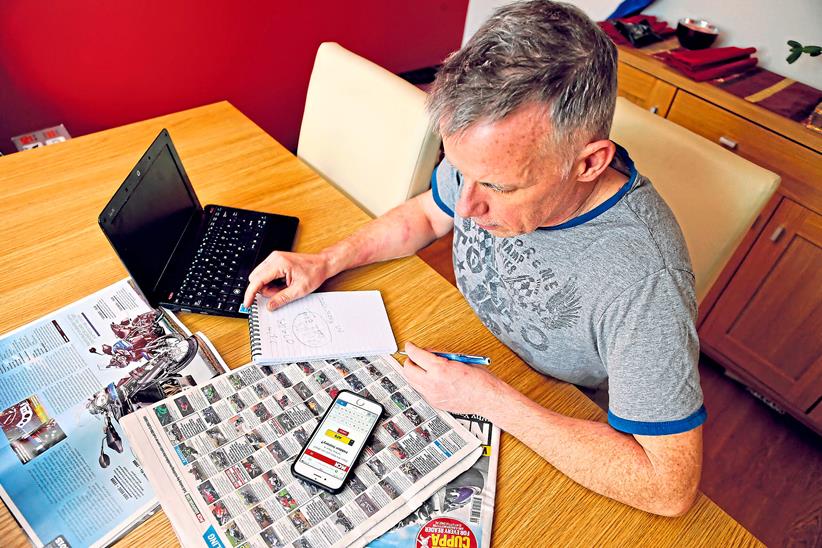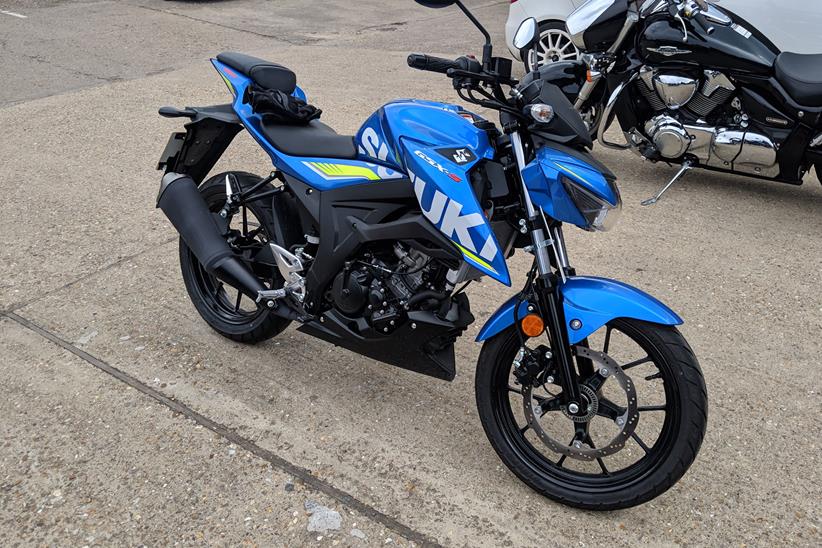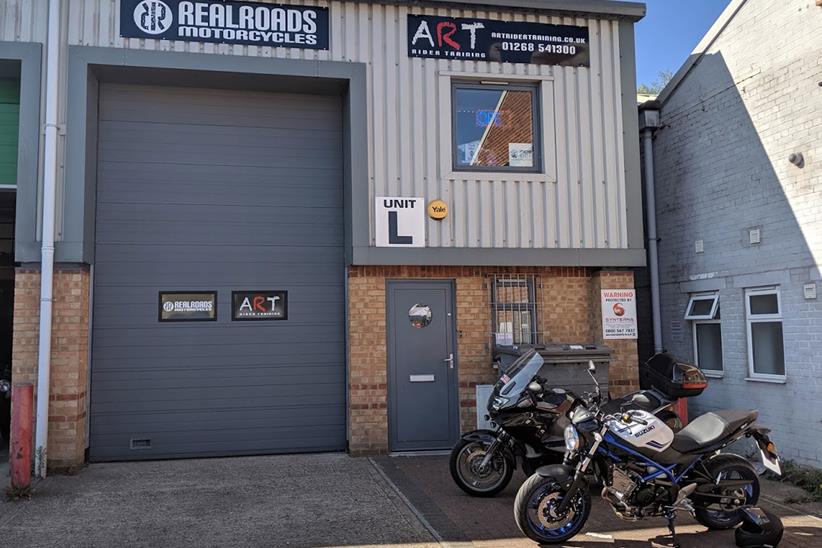Join in the fun and learn to ride a motorbike with the experts at MCN. You won't look back!
Welcome to your one-stop shop for everything you need to know about how to learn to ride a motorbike.
Motor Cycle News are the renowned experts in every aspect of life on two wheels, and that includes getting started in the first place.
From this page you can jump to articles explaining how to pass your test and lose the L-plates, the kit and bikes you should consider, and plenty of tips for safer, better riding and advice on looking after your bikes. You can even find cheap bike insurance with MCN Compare, and find bikes for sale near you.
Jump to:
- How to pass the UK motorbike tests
- Picking the right bike
- Choosing the right riding gear
- Basic riding advice
- How to look after a motorcycle
- Case study
How to pass the UK motorbike tests
Of course, before enjoying the freedom of two-wheeled life on the open road, you’ll need to get a licence sorted.
It’s possible to ride a 125cc motorbike in the UK by getting a CBT alone, as long as you’re 16 years old or over, but you’ll need to display L-plates, steer clear of motorways and won’t be allowed to carry a pillion (although you probably don’t want to with a 125 anyway…).
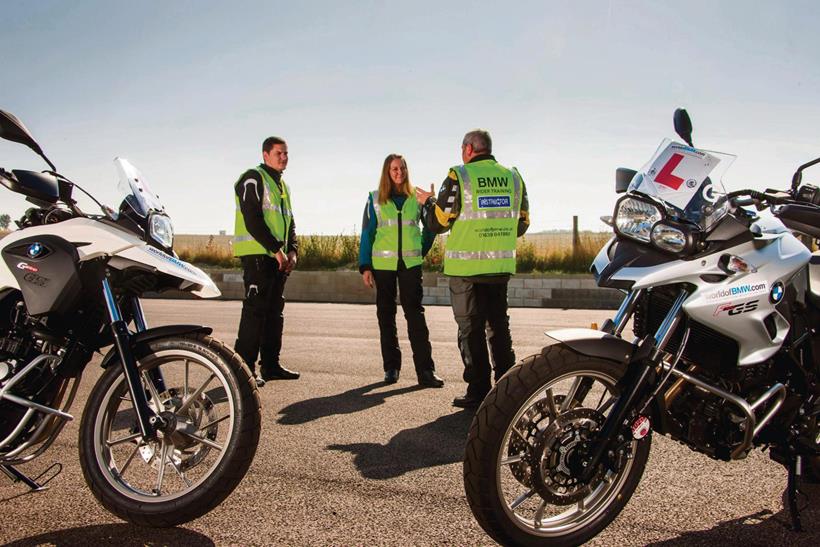
But most people want to move on to bigger bikes, and in order to do that, you need to pass your full UK motorbike licence.
However, that only applies if you’re 24 years old or over. If you’re not, there are a few more hoops to jump through, including the A1 motorbike licence, followed by the A2 motorbike licence.
Confused? You can learn more about the process for getting your licence in the infographic below:
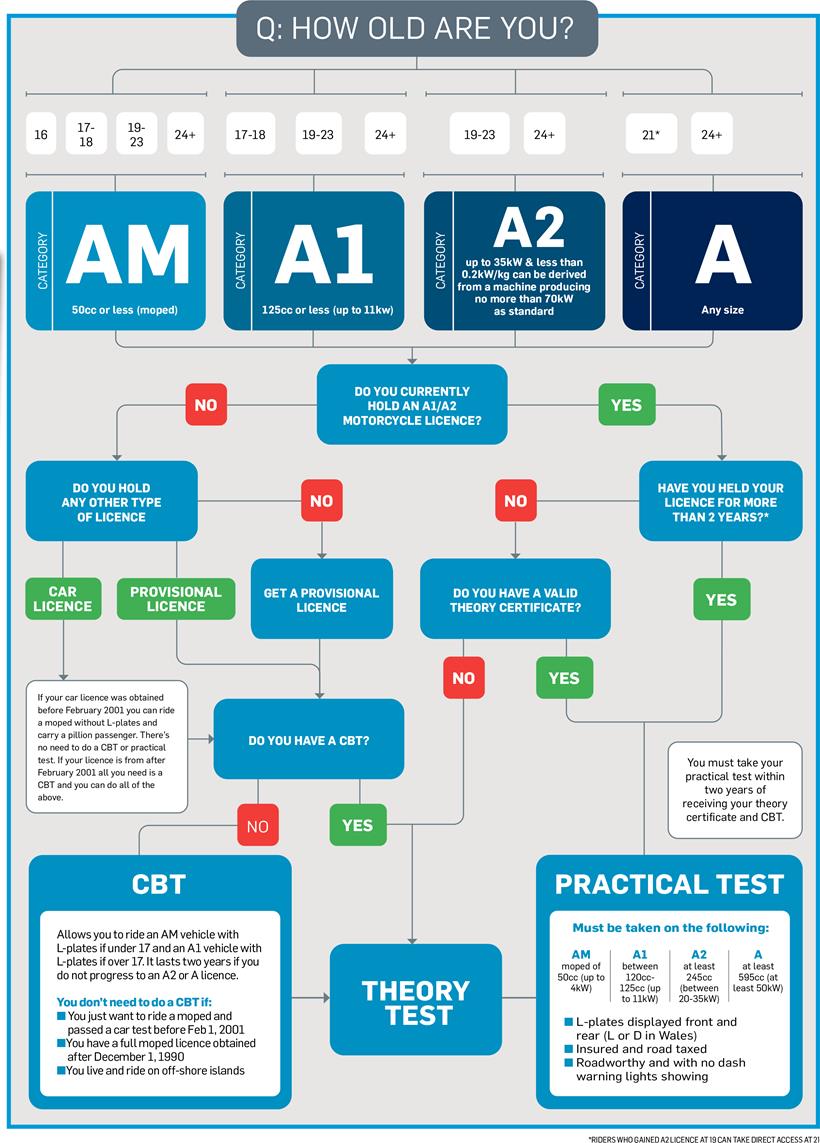
And before any of those, you’ll need to pass the UK motorcycle theory test.
Picking the right bike
Whichever level you’re at, MCN can help you pick the right motorbike for your requirements. Whether you’re searching for the best 50cc scooter to get you started in your biking life, a great 125cc to set you up for passing your test, or looking for an A2-ready motorbike, we’ve got articles to help.
And once you’ve passed, the fun really starts!

Choosing the right riding gear
We’ve not all about the bikes, though. Head into our bike kit section to find articles such as the best riding kit for beginners, and wallet-friendly stories like the best budget bike gear.
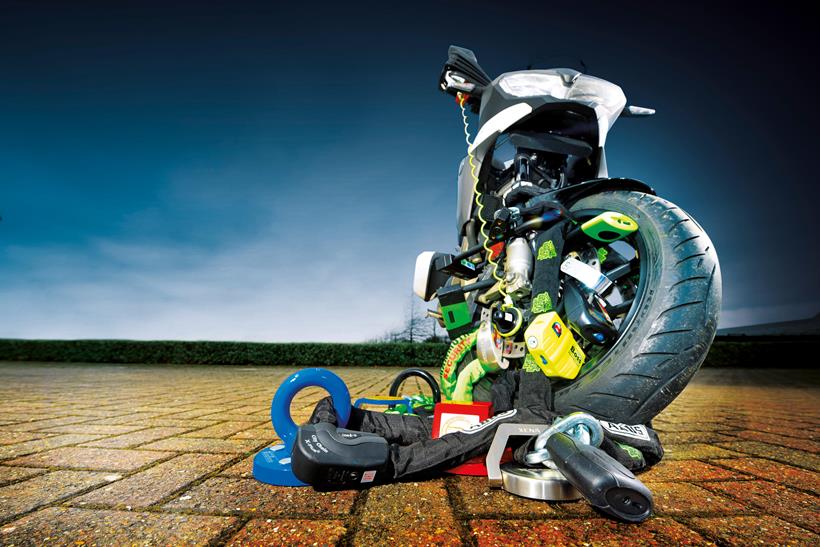
Searching for an entry-level lid? We’ve got you covered. Bike security? That’s a crucial topic that we cover in huge detail.
Basic riding advice
Another thing MCN is an authority on is riding advice. We’ve got articles that explain things right down to the very basics, including how to physically ride a motorbike, and critical elements of passing the test such as how to U-turn or avoid stalling at traffic lights.
We’ve got advice for riding in heatwaves, navigating your first winter, riding in strong winds and how to carry a pillion.
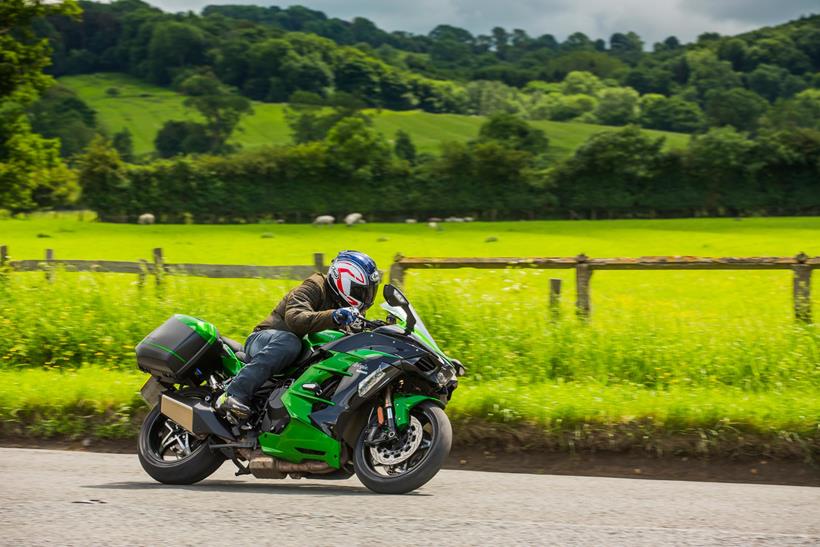
One of the big advantages of riding a motorbike is the ability to pass through queuing traffic, but don’t try it without reading our guide to filtering first.
Then there are legal aspects to consider – we’re big advocates of staying on the right side of the law!
How to maintain a motorcycle
Every week we also offer how-to articles on completing various maintenance tasks on your bike. Whether you’re keen to learn how to change your oil and filter, or try something easier like how to look after your chain, we’ve got all the information you need.
That extends to preparing your bike for winter storage, but if you’re thinking about continuing to ride through colder periods, fitting some hard-wired heated gloves could be a great shout too.
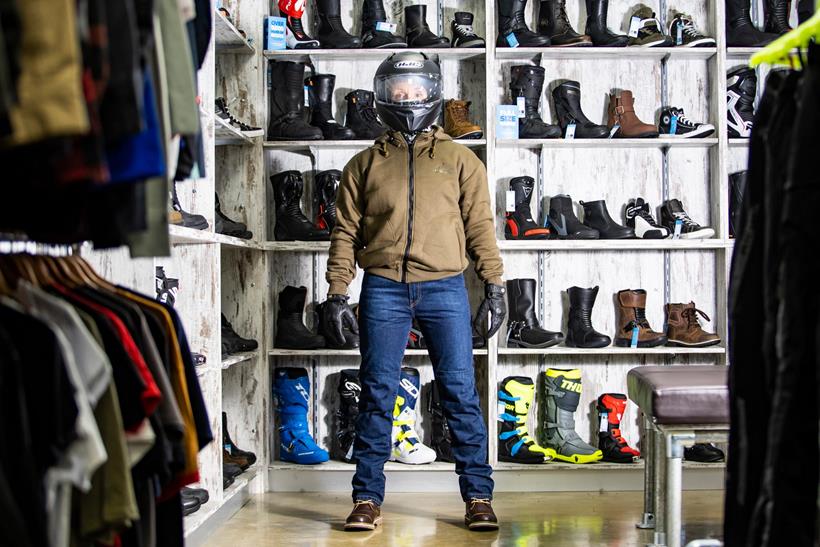
Verdict
If you’re learning to ride a motorcycle then MCN has the right advice for you, from bikes to riding tips, and passing the test, through to the best gear for you.
All of our articles are written by bikers, for bikers. Find out more about why you should trust us right here.
Case study: How to learn to ride a motorcycle
If all that seems a little complex, and we wouldn’t blame you if it did, then read on for a real-life account of our then-Online Editor Gareth Evans, and his journey from humble car driver to full-fledged motorcyclist.
And don’t forget, once you’ve completed your journey to full A licence, you’re only just starting your journey on two wheels. There’s plenty of advanced motorcycle training available to take your knowledge, skills and safety to the next level.
First update: all the gear and no idea…
First published 02/05/2019
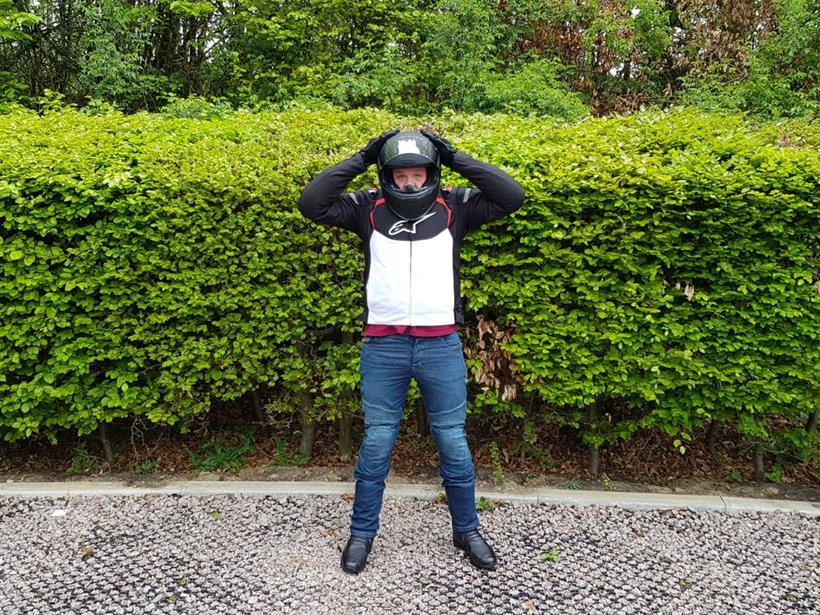
It was around 2am when I shot bolt upright in bed. No, not what you’re thinking – it was the realisation that it’s time to learn to ride a motorbike.
Jump to
- Second update: my first motorbike insurance policy
- Third update: doing the CBT – on video
- Fourth update: the first 100 miles
- Fifth update: basic bike wash
- Sixth update: the motorcycle theory test
- Seventh update: Mod 1 mayhem
- Eigth update: Mod 1, take 2
- Ninth update: Mod 2, done!
I’d been keen on bikes for years, but only from a distance, because until very recently I was in the car industry and so that’s where most of my attentions faced. A new job away from cars was all the inspiration I needed to make the leap, so I’m going to document my journey here. Hopefully it’ll give you something to send to any budding bikers out there to inspire them to do similar…
As a little background on me, I’m 35-years-old, have held a full UK car licence since I was 17, am a keen motorsport enthusiast and love all kinds of engineering. My riding experience is little more than buzzing around on a 50cc twist-and-go for a brief period when I was 16, however. I’ve got basically no idea how to operate a bike with gears!
Step one: choosing rider training and a bike
Once I knew I wanted to try motorcycling, the first thing I did was Google motorbike licences. This brought me to MCN’s new Advice section, where I found two articles in particular that were to prove incredibly useful: How to Ride a Motorbike, and How to pass your full UK motorbike licence.
Now, I had to decide what to do first. From the above articles it’s clear you can achieve very little on the road in Britain without a CBT – Compulsory Basic Training – so that quickly went to the top of my to-do list. I quickly located the nearest school with a good reputation (it’d be with Shires, who are based out of Wheels in Peterborough), but in order to do that I needed a bike to do it on, and some kit in case it rains, or I’m particularly inept at riding once I’ve got going.
The bike turned out to be the easy bit. I’m keen to do this properly, so it had to be a geared 125 – the largest-capacity engine you can use without taking more intensive biking tests.
A chat over a beer with MCN’s youngest expert bike reviewer Dan Sutherland at the Carole Nash MCN London show threw up some interesting options, but he absolutely raved about Suzuki’s GSX-S 125, telling me it’s approachable and safe but loads of fun at the same time. He’d covered the launch of the bike for MCN and I fully trust his opinion. The Suzuki sounded good to me!
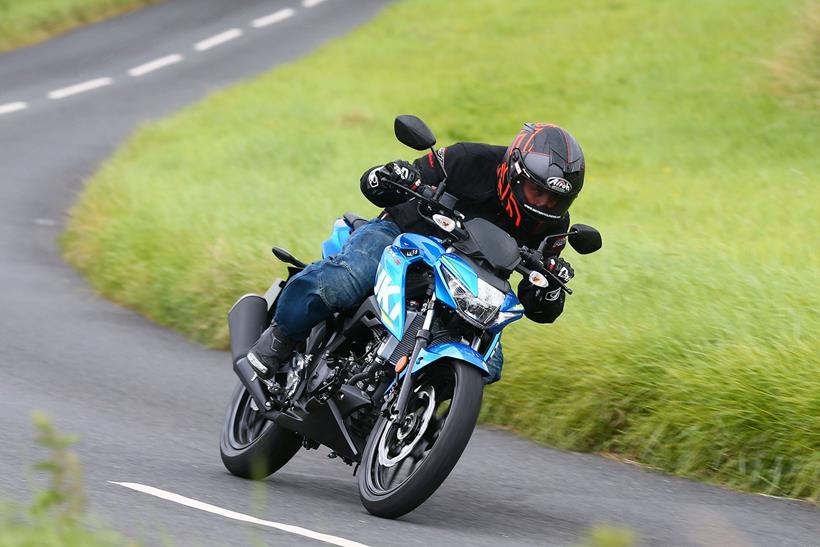
The one I’ve ended up with isn’t new. It’s got 1300 miles under its belt already, and I’m told that means it’s just about run in. Hopefully I can avoid any teething issues with the bike, because there are bound to be loads with me and my riding!
Step two: kitting out with bike clothing
Now on to the kit. I knew I didn’t want anything too… let’s say, ‘racy’. I know my capabilities are lightyears from lighting up the rear tyre on a lap of the TT. In fact, flying under the radar is more my preference, but that’s not always a good thing, as I was to find out in my CBT course later on. I should have borrowed some kit until I’d done that, if I’m being completely honest.
So I went for a matte black helmet from Icon. This polycarbonate full-face lid, according to the specs, is called Airform Rubatone and comes with an integrated sun visor and a moisture wicking removable interior. They both sound like useful features. You’re also able to customise it thanks to the removable spoiler at the back, which plays to my desire to tinker with everything I own. Maybe in a few weeks.
I tried a few on around the same pricepoint and this one seemed to fit my head best. It’s priced at £136.00 at time of writing, which didn’t sound too bad to me.
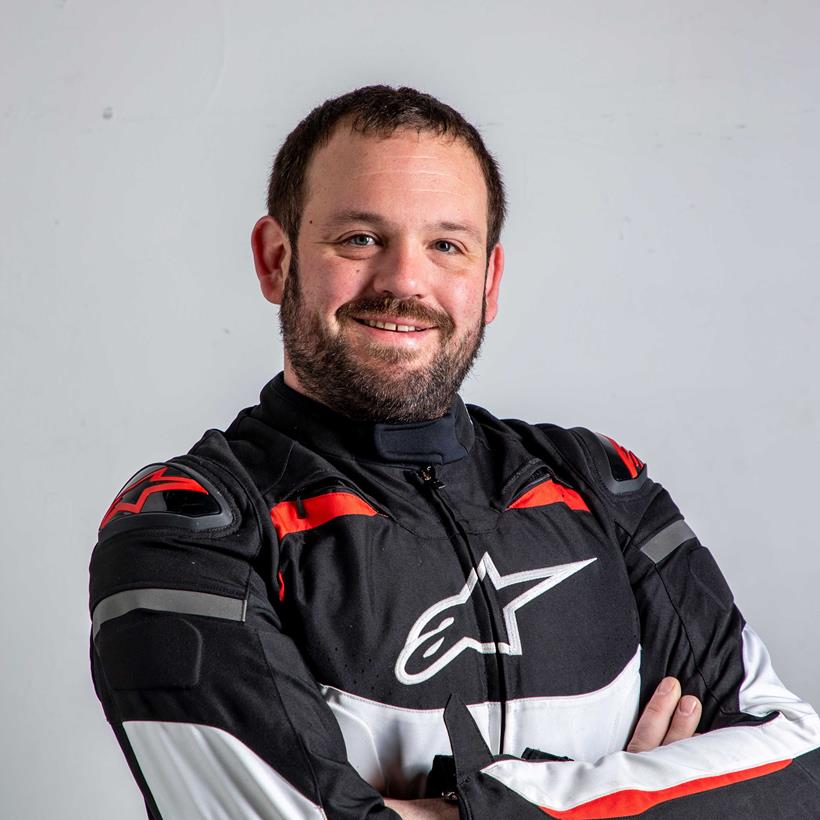
Slightly more visible is the Alpinestars T-GP Plus R V2 jacket, which costs £199.99. While I may not have picked this particular colour scheme, I was amazed at how well this fitted my torso. I’m not sure I’ve got a jacket that’s more snug yet liberating – it’s very breathable, has loads of vents, proper CE Level 2 protection for elbows and shoulders, VELCRO fastenings and loads of pockets. Quite a spec! My only concern was the main zip, which felt a touch flimsier than a lot of the other kit I’d tried and harder to locate when zipping the jacket up. I’m sure I’ll get used to it, though.
Fashion meets function
The two-layer black Hein Gericke trousers I’d found went off sale a long time ago and weren’t particularly comfortable, taking me ages to get into them as I learnt how all the kit went together. But then someone in the office asked me whether I’d be wearing some “riding jeans”. I’d not considered this was even possible, but it turns out my favourite legwear is also available with the kevlar protection required to be legal and safe for riding a bike.
There are actually countless designs on the market, but after a bit of investigation I settled on a pair of denim-look Furygan Steeds. I was surprised to note they’re not too much more expensive than my regular jeans, weighing in at £159.99. They’re new for this year, and my first impressions when I unpacked them and tried them on were good – they’re comfy, despite the extra padding in crucial places. It took five minutes to work out how to sit down without pinching a little, but now that’s done I feel like I could wear them all day. I suppose that’s sort of the point…

For the extremities I went for some RST Raid multipurpose gloves – black, comfortable and protected across the knuckles, but also usefully dextrous enough to allow me to take my lid on and off without removing the RSTs first. That could be useful at a petrol station.
The Forma Majestic boots (£129) don’t rewrite any sort of fashion rules either, but all the right ingredients are included: waterproof, robust-feeling zip, sturdy protection around foot and ankle. It’ll be interesting to see how they loosen up as I start to clock up some miles.
So now I had all (well, most) of the gear, but still hardly any idea. Time to change that, and on to my CBT via sorting our insurance.
Second update: my first motorbike insurance policy
Now, I’m booked to do a CBT next week, which I’m very much looking forward to, but first I’ve been having a look at a little matter called motorcycle insurance. We all need it if we’re going to ride on the road, and that’s what I’ll be doing on the second part of my CBT, assuming all goes according to plan.
To find out how much I’d be stung for, I fired up MCN Compare’s comparison tool and went to work inputting my details. Other companies are available, of course.

My rough profile is as follows:
- Age and marital status: 35, married
- Postcode: PE8
- Work: editor in publishing
- Type of licence: provisional, car licence held since 2001
- Annual mileage: 5999 (wishful thinking..?!)
- Bike usage: social, domestic and pleasure, including commuting. Kept on driveway locked with alarmed disc lock
- Voluntary excess: £300
The best quote came back at £318.06 for the year, courtesy of MCE. The lump sum could be split into a £50.71 deposit and eight instalments of £43.95. I’ve no idea why eight payments, but that’s what it said!
Oh, I’d need to tax the bike too – VED costs £20 a year for bikes under 150cc, or £21 if you split it over 12 months. Things aren’t quite that tight, thankfully.
Now that’s all sorted, I’m ready for my CBT. Keep an eye out for the video diary over the coming days…
Third update: doing my CBT… on video!
This week’s video update sees Gareth take his CBT at Wheels in Peterborough. Special thanks to instructor Matt Hardwick from Shires Motorcycle Training.
Third update: my first 100 miles
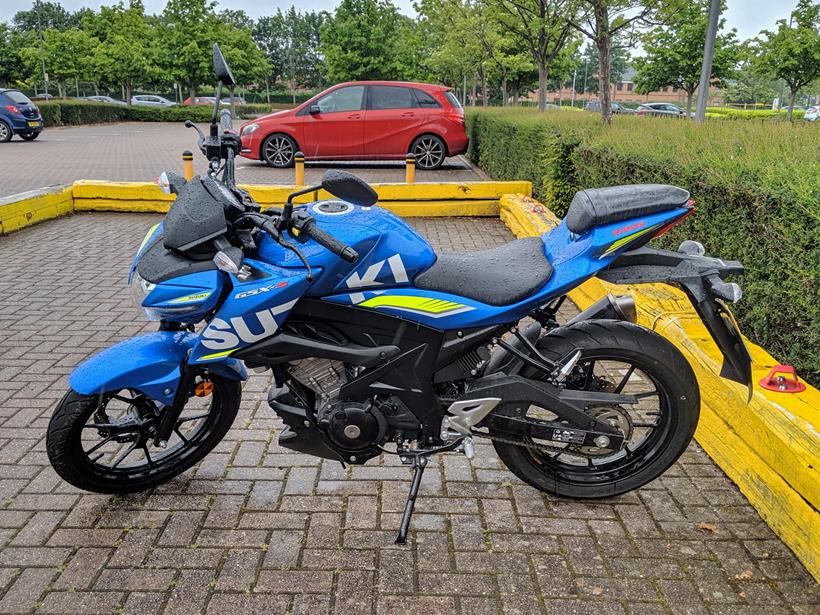
After passing the CBT, I was free to get out there and learn to enjoy this Suzuki GSX-S125 – which incidentally I still can’t quite pronounce when people ask what bike I’m riding. The arrangement of letters seems to make my tongue double in size. I’ll have to work on that.
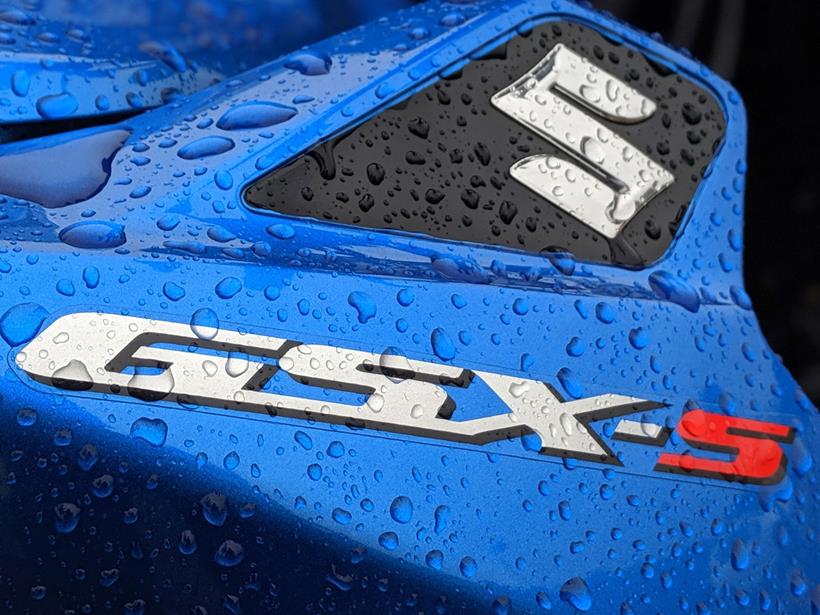
Anyway, I was ready to ride on the open road, and ready to find out just what this motorcycling malarkey is all about.
Except Mother Nature took matters into her own hands to ensure I didn’t have too much fun. The first night I’d planned to take it home, it rained. The morning after, it rained more. The following evening? You’ve guessed it…
Now, I’m not about to start moaning about our Great British Weather. I’ve spent 35 years getting to know and love it. However, it put the kit I’d picked directly into focus, and caused a few more wallet wobbles as I properly acclimatised to the situation.
On the first evening it became startlingly clear my rucksack wasn’t up to the job. This laptop-laden luggage was sopping by the time I’d reached home after 17 miles of prodigious precipitation and frankly, the electronics were in danger. When I got home I also realised that the bike would need to be left exposed to the elements (albeit tucked securely away) over a weekend, and while a motorcycle should be waterproof, it didn’t seem right to leave it out for days on end with such poor conditions.
Take cover!
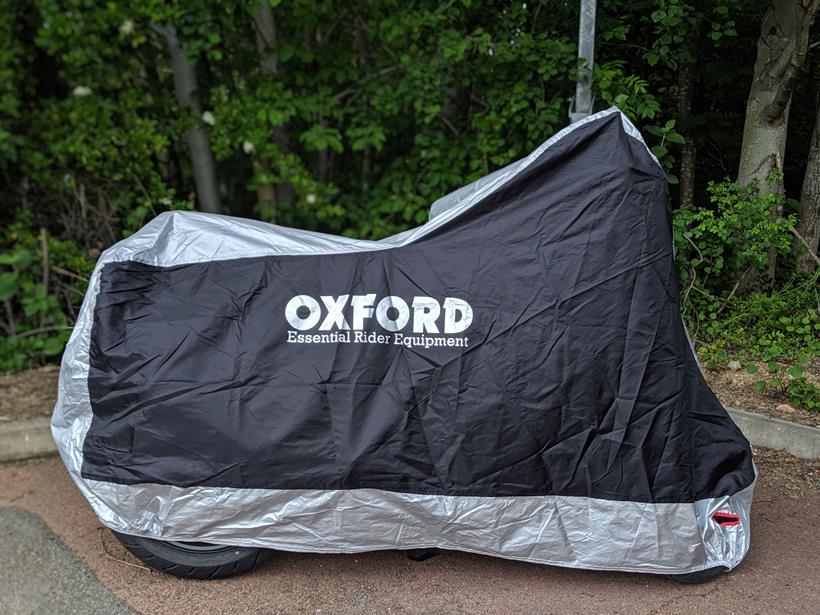
I ordered a cover to fit the GSX-S, which cost £24.99, and an Aqua V20 backpack was £49.99.
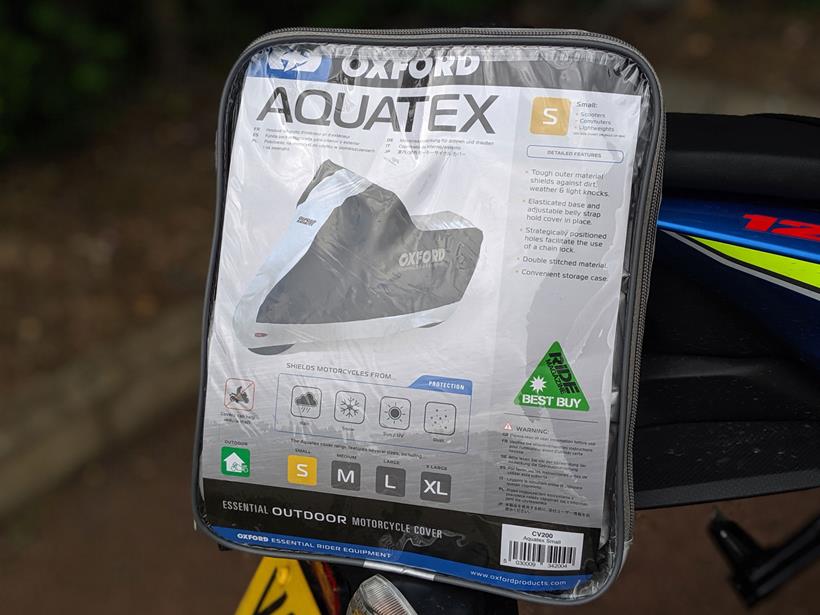
I found the cover a surprisingly tight but accurate fit, with a belly strap to keep it on the bike, breathable fabric to prevent mould and a hole for a disc lock at the front. More on that later…
The bag came in high-viz, which if you remember back to my first update, was something I’d been told can only be a good thing when you’re learning to ride. It also holds 20 litres, has waist and chest straps for security while riding, and feels incredibly robust. In fact, it feels like the same material they make RIBs – Rigid Inflatable Boats – with. A sort of heavy-duty waterproof rubber.
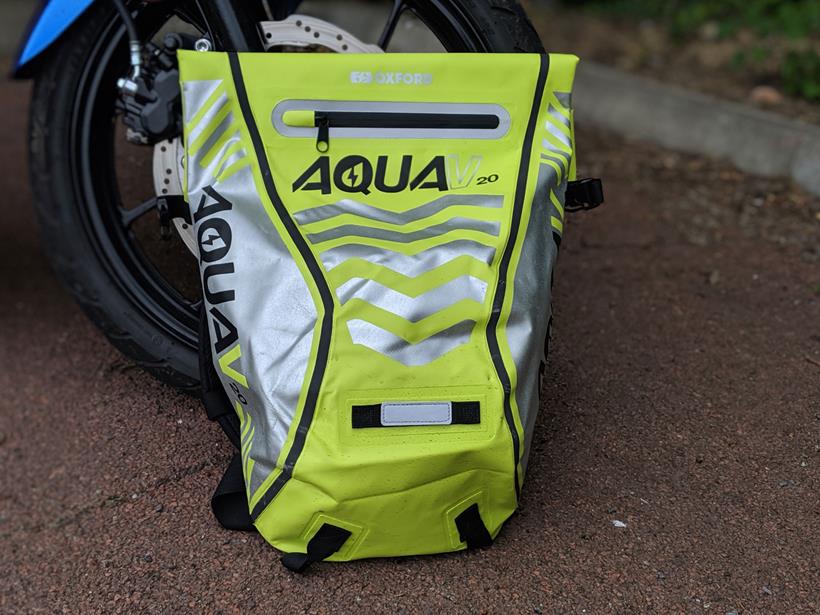
What followed was a total reassessment of my logistics as I adjusted to spending what felt like half my life getting in and out of biking gear.
It meant being more strategic with where I left items of clothing, ensuring I had viable, non-biking attire for work activities where necessary and not leaving anything I need to ride anywhere it wasn’t useful.
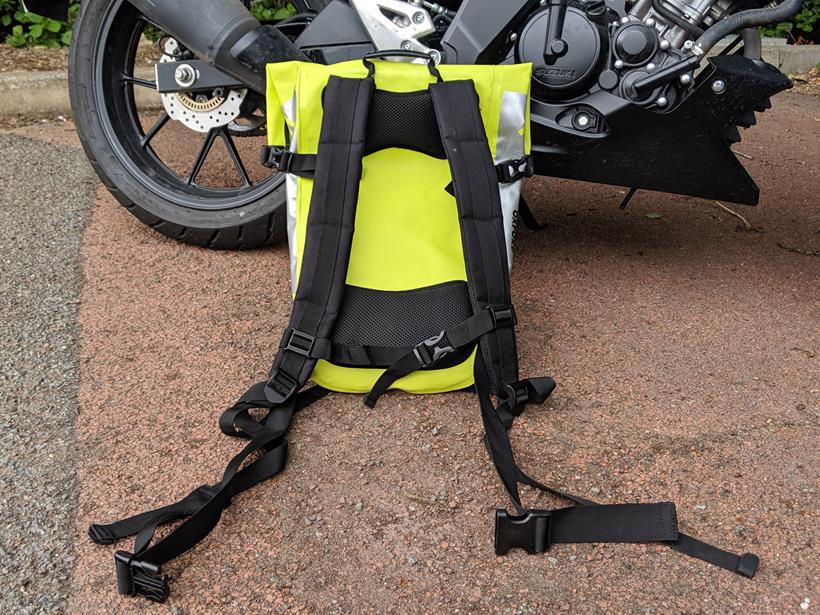
I’ll admit there were a few trouser teething troubles here. While I’m a big fan of the riding jeans I’d sorted before the CBT, the two-layer waterproofs got a lot more use in the first instance. A few times I found myself wearing just the lower layer (easier, quicker, cooler and more comfortable than both) when it rained before I learnt it’s probably a good move to carry the outer layer in my backpack. Obvious, maybe, but not necessarily to a new biker wondering what on earth he’ll encounter each time he heads out.
How’s that bike treating you?
I don’t have many things to say about the GSX-S125, and that’s not because I don’t want to have to keep saying its name.
However, I will say I find the riding position comfortable. Its naked design with upright stance seems to suit what I’d imagine my riding style will evolve into.
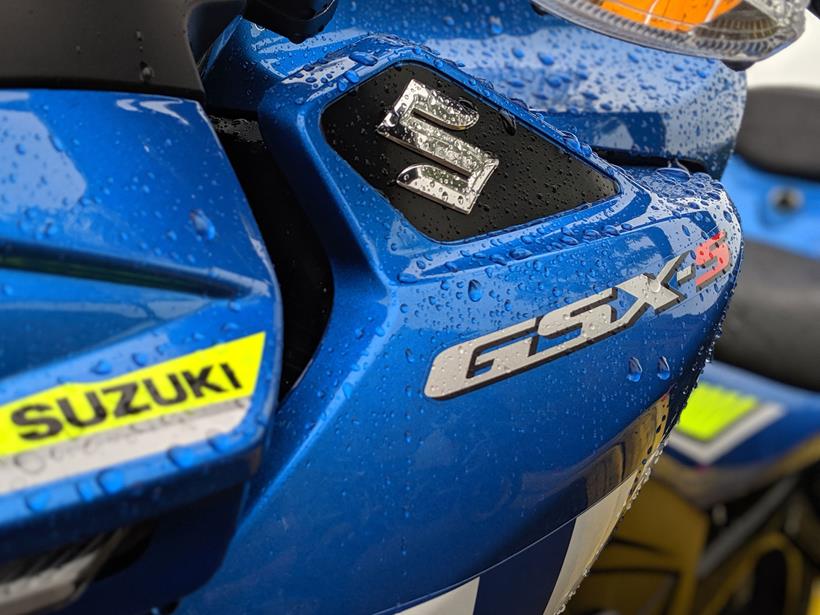
But after 100 miles, I’ve discovered one issue, and that’s its performance. My ride home involves a fair amount of national speed limit B-road, and this Suzuki doesn’t do much more than that.
While I’m not wanting to go warp speed the whole way home, I’d appreciate the extra safety net that more power offers you when you’re above 50mph or so. Being able to extricate myself from situations isn’t something I’d thought about, but now I completely understand why some more experienced riders write in to MCN saying you should be able to skip the enforced 125 step and move directly to a feistier machine.
It hasn’t all been wet and expensive, either. In fact, I’ve had two(!) rides to and from work in beautiful, warm sunshine. During those cushty commutes I really began to understand what this brilliant lifestyle is all about. That feeling you experience when you lean the bike into a bend and come out precisely where intended is a thrillingly addictive one, and something I can only imagine will improve as my limits widen and I get used to the bike. I can’t wait to ditch the L-plates already… and I haven’t even had to fill the bike up yet!
- Suzuki GSX-S125
- Mileage: 1401
- Fuel spend so far: £0
Fourth update: basic bike wash
I’ve done a few hundred miles now and most of it was in the rain, so time to clean the Suzuki GSX-S125 for the first time…it was time to get bike tester and expert Dan to show me what to do. Watch the video above to see how I got on.
Fifth update: 125 shootout

This week on MCN we published a feature that would have been very useful for me a few months ago while picking my bike. The best 125cc motorbikes article takes some of the most popular bikes that I can ride right now with my current licence – a full UK car one with a CBT, which means up to 15bhp and not more than 0.1kw per kg.
So reading through the options, the obvious question is: would I have chosen any differently? Given I’m an inexperienced rider, I’m not in a position to comment on the differences in powertrain performance or chassis design, but I will say I’m pleased I went for a naked design with a more upright riding position. The equivilent sportsbike design, the GSX-R125, requires a more hunched-over approach that I think I’d find less comfortable now that I’ve started doing longer rides of up to an hour. I’ve become more of a fan of the look of the sportsbike approach, however, and can fully understand why you’d buy one like that. Particularly if, as in the Suzuki’s case, you can buy it in race-replica graphics from MotoGP.
I’d like to have tried the KTM 125 Duke given another shot at buying a 125. It looks just as comfortable as the Suzuki, and arguably slightly more interesting, but I’m told it’s a bigger bike as well, which should mean it’ll be more comfy for my ample frame.
Still, I’m enjoying the little GSX. I’ve just buzzed past 300 miles on the odo and I’m out riding a lot. I’ve also discovered the joy of £11 fill-ups at the petrol station – I’ve filled up twice, and some basic maths shows I’m doing around £1 per 10 miles, or 10p per mile. That’s pretty decent value for money considering how much fun I’ve been having…
Sixth update: passing the theory test
Published August 8, 2019
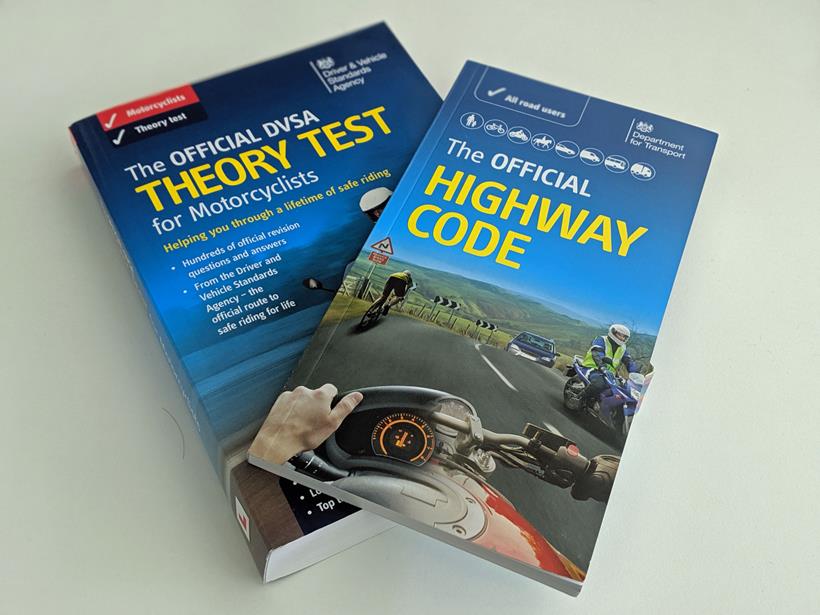
It feels like years since I did my CBT, but alas it was only a couple of months ago. In that time I’ve been riding, but also reading, because I needed to swot up for my motorcycle theory test.
My revision material comprised of two books – the Highway Code and an official DVSA Theory Test for Motorcyclists (shown above) – and some online tools, which provided mock exams as well as familiarisation of the look and feel of the test itself.
I say test, but it’s actually split into two parts. The first is the multiple choice portion, followed by a hazard perception test. It costs £23, takes around an hour, and I registered to take the test in Peterborough.
So the past few weeks have been full of revision and practice as I prepared. Entering the building on the day of the exam, I’ll admit I was pretty nervous. I’d got the facts and figures of the multiple choice part there or there abouts, but the hazard perception was playing on my mind. Not only had countless people told me how a) hard it is to pass, and b) how unrepresentative it is of normal road riding, that I wasn’t entirely sure I’d get it right.
You see, it’s a generic test aimed at those who’ve never used a road in their life before as well as more experienced drivers, and therein lies the problem – if you’re used to observing hazardous situations unfold on the road, you’re likely to highlight them earlier than the computer is ready for in this exam. That, along with the lack of any cursor on the screen (sounds trivial but it was enough to throw me) had me worried.
But alas, an hour later I walked out of the building with a pass certificate. As expected I’d done fairly well on multiple choice, dropped two points of the maximum 50, but my hazard perception score was a poor 49 out of 75. The pass mark is 44, so I’d done it by the skin of my teeth.
Still, I’m through it and it’s job done. Now onto investigating my mod 1 and mod 2 practical exams after some rider training on bigger bikes. It’s starting to get real…
Seventh update: Mod 1 mayhem
First published 30/08/19
I’ll be the first to admit I wasn’t ready to take my Mod 1 test. I’ve got a variety of excuses a racing driver would be proud of, but the fact is, I failed. I couldn’t perform a U-turn under power.
The thing is, Mod 1 is not easy. Well, not for me, anyway. It was my first test on a big bike – a Suzuki SV650 that bears almost no resemblance to my 800-miles-covered GSX-S125 – and despite several hours of patient, excellent training from the experts at ART Rider Training in Basildon, Essex, I couldn’t get my hands and feet to coordinate, and I ended up putting a foot down on the DVSA pad, failing the test instantly.

I’ll freely admit I was nervous when the gates shut behind me and the test began, so despite managing several U-turns during training, I think part of my problem was simply that my brain found its limit. Everything fell apart when the examiner asked me to turn the bike 180 degrees within a 7.5-metre diameter between two lines simulating a road.
What is Mod 1?
Module 1 is the first part of the practical test to gain your full UK motorbike licence. It’s all carried out on the DVSA test site, which has an airport runway-spec apron called the Motorcycle Manoeuvering Area and 78 cones – all of which you’re meant to avoid hitting while carrying out eight tasks:
- wheeling your bike and using the stand
- low-speed riding in a slalom and figure-of-8
- a slow ride
- a U-turn
- cornering and a controlled stop
- cornering and an emergency stop
- cornering and hazard avoidance
Ironically, I managed seven of the eight with little problem. But that blasted U-turn needs more work. Guess what I’ll be doing on the 125 every day until I can book another test?
It’s hard for a reason…
Learning modern motorcycling is harder than I was expecting, but at least the crash statistics are moving in the right direction as a result of this latest testing regime, introduced in 2009 in response to data showing the majority of motorbike accidents occurred at low speeds. There’s method behind the mayhem, then.
Eighth update: Mod 1, take 2
First published 09/09/19 by Gareth Evans
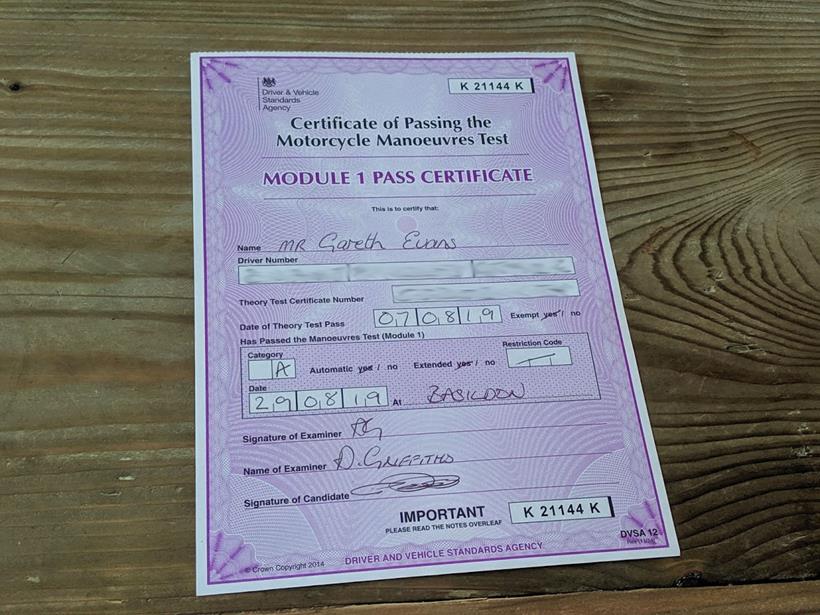
A week after I’d failed my Module 1 motorcycle test I was back for another go, but not before some more training from Rich and Andy at ART Rider Training in Basildon, Essex. I wanted to nail this U-turn malarkey once and for all, so before I went down there I’d done countless practices on the GSX-S125 and loads of slow-riding miles.
It’s a very different bike to the SV650 that I’d been doing all my training on, however – so different, in fact, that I found low-speed direction changes comparatively easy to achieve in the car park at work.
It was only when I was back down in Basildon on the bigger bike that I found I hadn’t quite cracked it. The SV is a willing companion but my arms and feet just wouldn’t coordinate. Was I in for fail number 2?
Thankfully, between instructor Andy’s and owner Rich’s patience, and some clever techniques in how to master riding at low speed under power – including at one point actually singing out loud in my helmet to try to overcome the car-driving brainwashing I appear to have given myself – it began to come to me, as we went over and over the drill.
My test was booked for just after 10am the day after my training, giving me the evening to practice and a few minutes beforehand. We’d agreed to not do too much, in order to give me the best chance of getting it right when it mattered.
So on arrival at the DVSA pad for my second shot at Mod 1, I was full of nerves but also confident that I could indeed do this. I just had to nail it when it mattered.
The gates opened, the examiner ushered me in and so began my exam. Frustratingly I wobbled more the second time around on the figure-of-eight test, and on the approach to the U-turn. I was convinced this was nerves, and at least I didn’t put my foot down this time. But had I passed? The rest of the test seemed to go alright, but these examiners give nothing away.
Asked to park my bike in the bay just outside the pad, switch it off and dismount, he put me out of my misery pretty quickly. “I’m pleased to say you’ve passed,” he said. It wasn’t perfect, though.
He’d picked me up on the above issues, so I walked away with two minor faults logged on the test sheet, but crucially I’d got myself past this particular pinchpoint and heading in the direction of Module 2 – the final on-road portion of the full UK motorcycle licence; providing you’re over 24-years-old, of course.
It took me approximately 14 hours of professional training to get to this point, along with all the ‘homework’ I’d been doing on the 125 in between. That wasn’t all on slow-speed riding, however, with a large proportion of it looking ahead to Mod 2. You’d go mad if all you did were U-turns and slaloms for the duration…
I can tell you one more thing about Mod 1: the 15-minute ride back from test centre to ART’s HQ on the SV was one of the best I’ve yet experienced. Bike tucked away, I left feeling happy. Now to find some time to take Module 2.
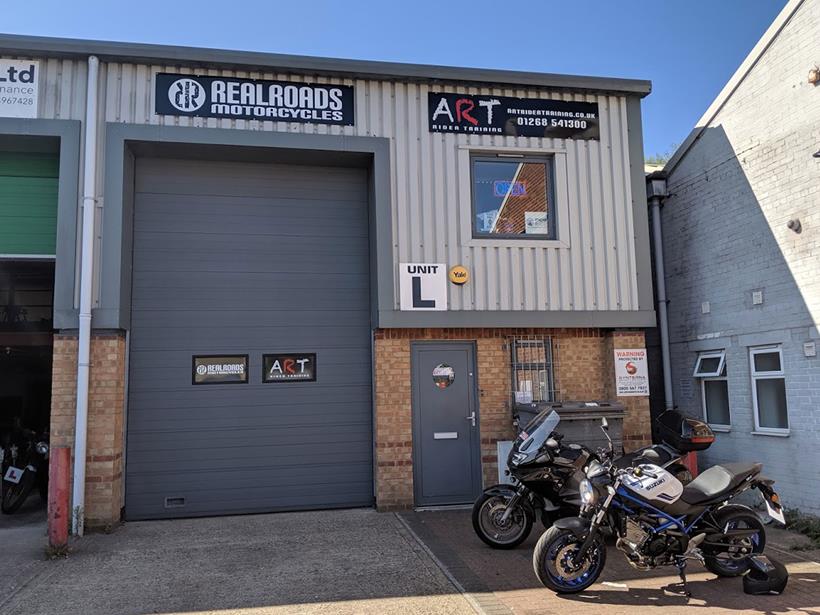
Ninth update: Passing Mod 2 and gaining our motorbike licence
After my two attempts at the Module 1 motorbike test, where you’re assessed on your low-speed riding skills (or lack of, in my case…), I was a little nervous about taking the final Module 2 section.
This final piece of the puzzle shines the spotlight on my road riding – awareness, safety and making reasonable progress. Having driven cars for years I felt a little better equipped to deal with this test, but there are plenty of additional aspects of two-wheeled motoring to take into account over and above how I’d drive a car.
To prepare, I had a pair of plans. First, I’d be riding the GSX-S125 as much as I could in varied situations. Plus I’d be taking another block of training with ART Rider Training down in Basildon on the 645cc SV650 so I could brush up on the bits I didn’t already know.
Here are the things I found most challenging as a car driver adapting to bikes for the UK motorcycle test:
- Rearward observations – I was struggling with making timely and relevant shoulder checks, which was the single biggest thing that needed work before the test. Rich and Andy at ART spent time explaining the whens and whys involved, and with a bit of practice using a Bluetooth communications system I got the timing nailed. I also brushed up on when, and when not, to check my mirrors.
- Making progress – You’re not expected to ride slowly during your test. You’re expected to be safe, but the last thing you want is to hold up other road users. With that in mind you need to demonstrate that you’re thinking ahead and making decisions that allow you to make reasonable progress. I wasn’t bad at this, but there were occasions when I would dither at a particularly busy junction or hesitate to pull out on a dual carriageway to overtake. Again, clear and well-informed instruction from ART saved the day here.
- Local knowledge – Apart from my previous rider training there, I’d never been to Basildon and didn’t know the area at all. This is both a blessing and a curse, however, because not knowing the roads does tend to help you concentrate on the important things. If I’d been more familiar, I may have treated the whole thing differently.
So, once I’d got another four hours of rider training in, it was time to head once again to the now-dreaded DVSA test centre in Basildon. I’d done enough training to feel slightly more relaxed, and it’s a good job too, because on the day nature threw rain and heavy wind into the mix. I also encountered an unexpected horse on a country lane, shortly before having to stop quickly to let an HGV perform a three-point turn on a bend, all during my 40-minute ordeal test. Sure enough, in the debrief the examiner said I hadn’t had an easy time of it.
The examination itself consists of a number of activities on a variety of types of road, aimed at proving you’re safe and proficient enough to handle two wheels in the real world. You start with a Q&A session on bike safety and maintenance, before swinging your leg over and heading out onto the road. You’ll do things like angled and hill starts, national speed limit sectors and a 10-minute ‘independent riding’ session to look at your ability to follow signs and act accordingly.
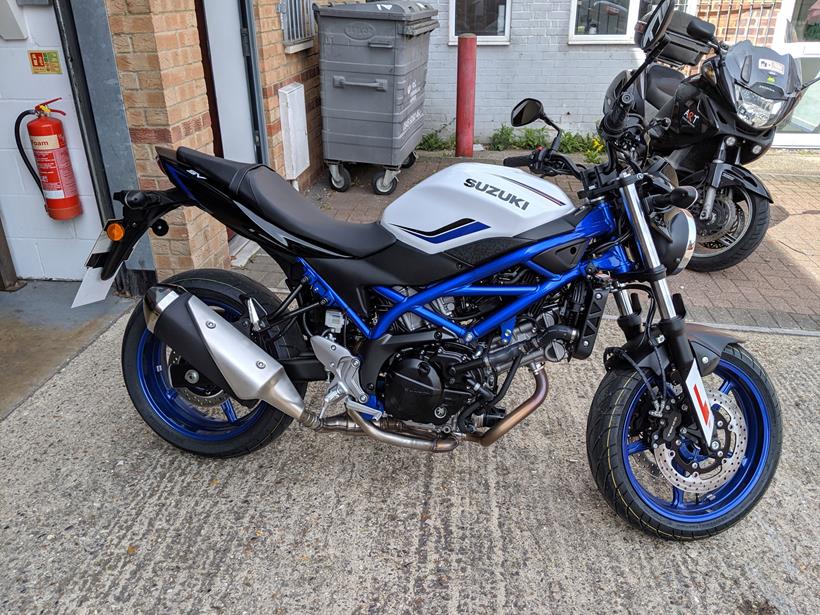
I took it on the same Suzuki SV650 I’d done Mod1 on – an approachable, friendly and engaging bike that I’ve come to gel with so much I’d quite like to get one myself – and focused very much on keeping my head up and planning ahead.
Cut to the chase: did you pass?
I did! The examiner marked me down for two ‘minor’ faults: a hesitation when accelerating and a steering fault. Frankly, with horses and HGVs along with the weather, I wasn’t sure how I’d done right up until the moment I learnt I’d passed. It was a huge load off. Here I am with the chap who took his test straight after me, also learning with ART.
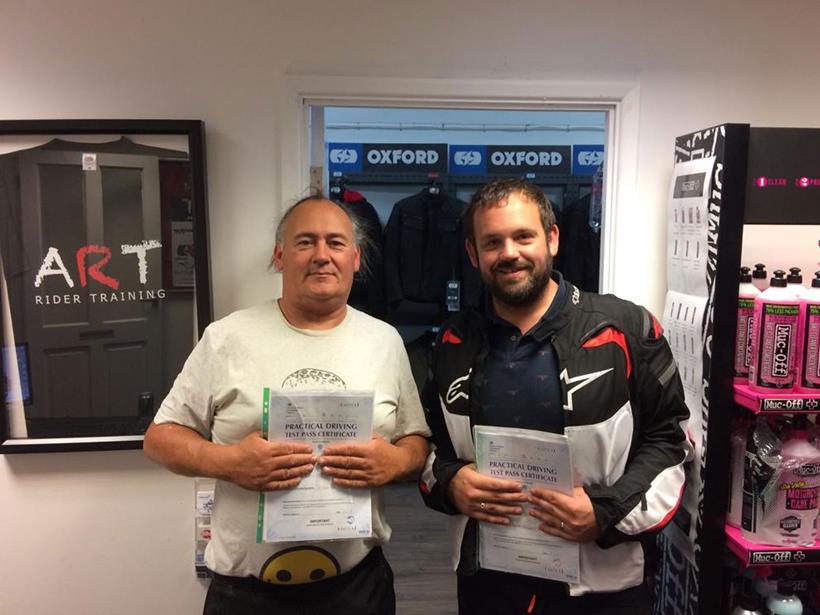
One thing I hadn’t quite bargained for was sending my licence off to the DVSA. At the test centre once you’ve passed they’ll either give you the option to send it off yourself, or do it for you. I chose the latter for simplicity, and consequently was left without this proof of ID for a number of days, including as I went on holiday, so no hire cars for me. My own fault 100%, but still.
You don’t have to wait for your new licence in order to ride, though. They give you the below certificate in its place:

Now a world of big bikes awaits, and I’m going to start my journey on the very same Suzuki I’ve got myself familiar with. Our very own star road tester Michael Neeves claims the SV is one of the best first big bikes you can buy, and I don’t need much more endorsement than that!
Oh, and one final note before I sign off from this part of my biking journey: if you’re learning to ride and struggling with any aspect, stick with it. I can assure you that the first time you head out on a bike, on your own, with no L-plates, is a moment that will remain in your mind forever. I’ve experienced the magical freedom of motorcycling and there’s no turning back now…
How long does it take to pass the UK motorbike licence?
I took my CBT back in May 2019, and passed in the middle of September. Sure, there are plenty of places that offer you a fast-track course in five days, but given my experience I wouldn’t recommend that. Put simply, you’re piling on huge amounts of pressure, and because you’ll have to prebook the tests, the likelihood of something going wrong and it costing you more money is really rather high.
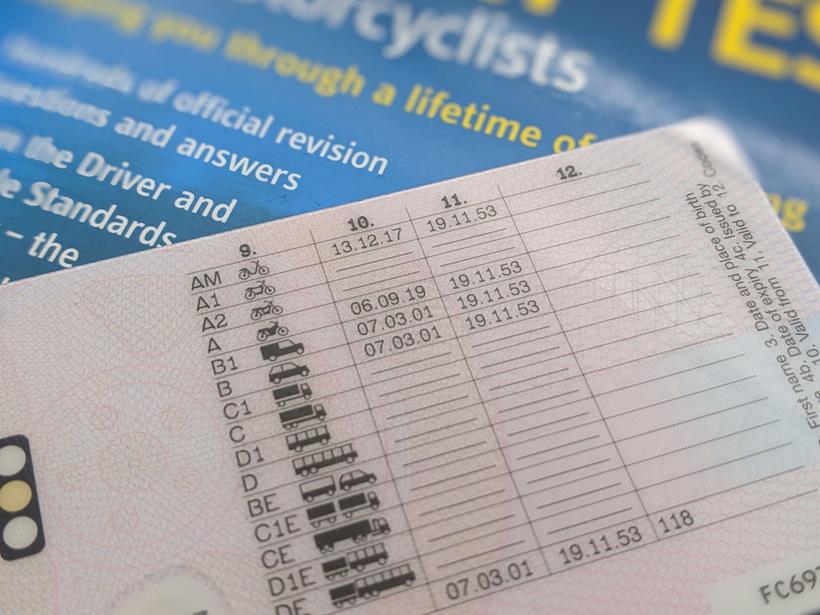
Besides, I think I wouldn’t have felt happy rushing through it like that. The reward of a career of safe riding is worth the time and effort to do this properly.
What now?
I think that now, the learning really begins. I need to get some miles under my belt, and learn to live with a big bike proper. I’m also going to do an ERS (Enhanced Rider Scheme) course, which is run by the DVSA and local riding schools. Upon successful completion of this, I can expect discounts on bike insurance. It takes 1-2 hours unless further training is needed. It’s a little like Pass Plus for new car drivers.
